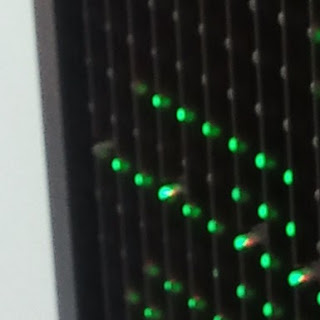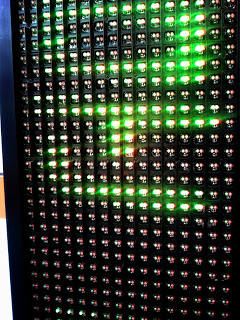Emergence, the name of my blog, keeps fascinating me. It occurs everywhere, but it is more clear in some cases. Here are two examples:
The cacti are ordered in a way, but the individual cactus does not contain any more information than it’s own color. By simply observing the single cactus, we can get informations on how common a specific color is, and what sizes they have and which position they have. But from the observation of the individual we cannot see the pattern. First when we take a step back we see that a pattern occurs:
The same goes for the LED display. When we only observe the blink of a single LED we cannot see the pattern which is on the display. But when we take a step back, the pattern occurs:
If you are wondering what is so fascinating or even interesting in this, then you make a good point about the magic the brain of all living creatures performs. The brain gets the information of individual dots (sensors) and in some way it can see the pattern and that even extremely fast and, in the case of humans, to a level where it is not to understand how it finds patterns. You may know the art of future telling in tea leaves (german: Kaffeesatz) or by interpreting the form of liquid lead which is held into water (german: Bleigießen). We can still see patterns in these random shapes, even if it is doubtable that there is any information in it. And we are even quite confident and agreeing in our interpretation.
For the brain research this is a big mystery and very fascinating. There are developed pretty good algorithms for special cases of this pattern recognition, but nothing that is as good as our brain. By far not. This makes emergence so fascinating and I’m wondering if we will ever get a computer to do pattern recognition as good as our brain.
We are doing about the same in another area: When we try to describe cultures and their commonalities. What is “typical Danish” or “typical German”? We can come up with some characteristics, but when we meet people from that culture nobody really is as the prototype. We have seen a pattern, but none of the individuals (necessarily) fits the description very well and the pattern is not visible in direct comparison between two random humans. Only by taking a step back and searching for the pattern, we can come up with the stereotypical descriptions. I think that this generalization from the pattern to the individual is what often can lead to misunderstanding of people from other cultures. In the end we are not very different (or sometimes we are, but the same goes also for people from the own culture!). This relation between the occurring pattern and the individual is another fascinating aspect of “emergence”.






Comments are closed.